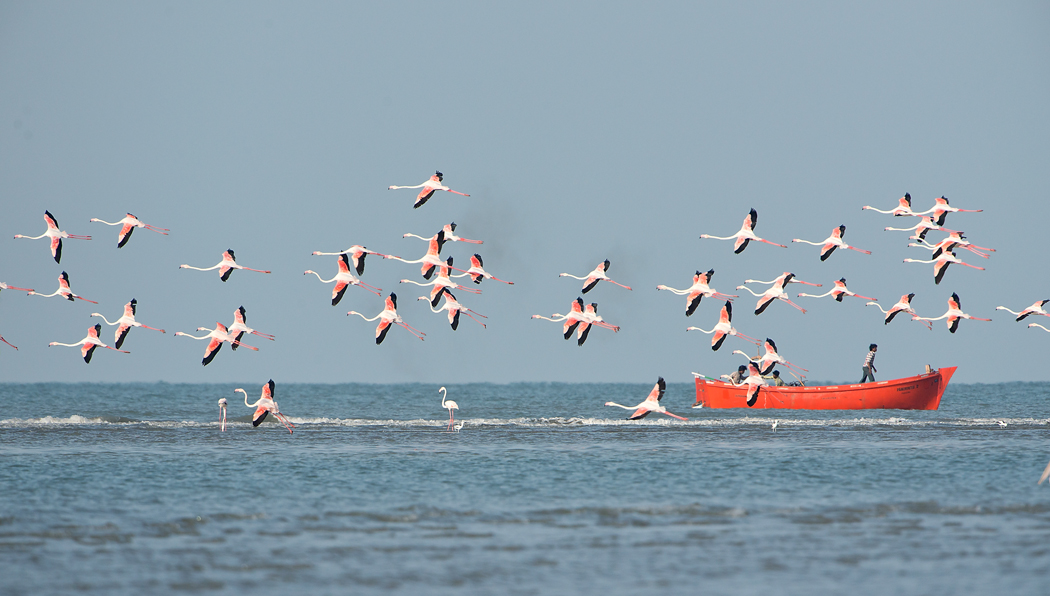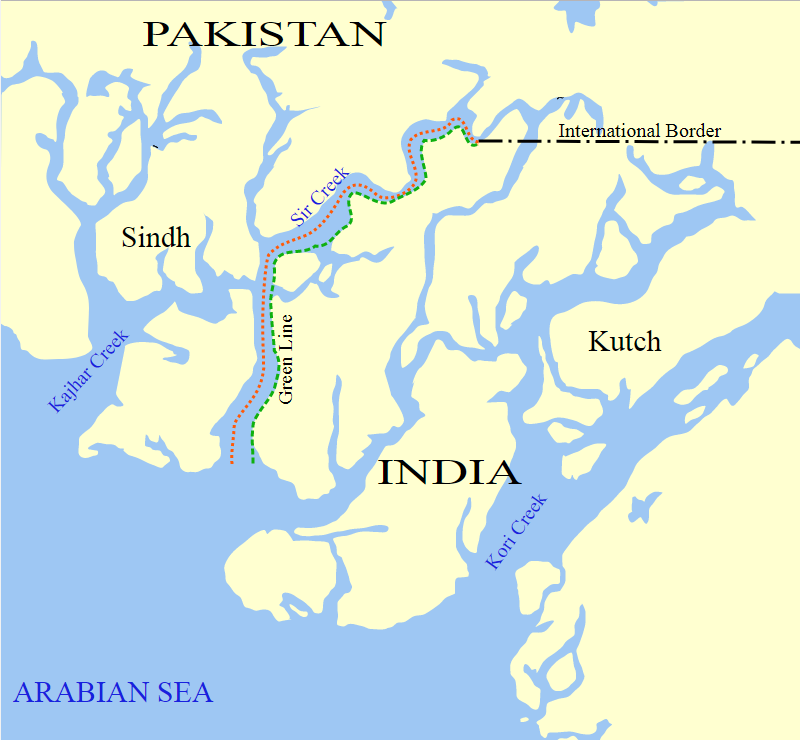
Introduction
The Sir Creek dispute concerns a 38-square-kilometer estuary near the ecologically significant Indus delta area south of the Rann of Kutch. The origins of the dispute can be traced back to the British colonial era when the princely ruler, Rao Maharaj, of the state of Kutch sparred with the government of Sindh province in 1908 regarding the collection of firewood from the creek. The Bombay administrative government’s resolution map, which was issued in 1914, placed the boundary of the creek between both jurisdictions on the eastern side of the creek. However, the textual explanation of the map stated that the boundary occurred at the midchannel point. Thus there was a contradiction between the map and the text that was never reconciled. The figure below provides a visualization of the competing claims.
After Pakistan’s and India’s independence in 1947, the creek was physically noted as the border between India and Pakistan but no formal resolution of the 1914 map’s ambiguity was determined. The war of 1965 between India and Pakistan over various territorial differences also involved the Kutch region. Subsequently, both countries agreed to take the matter to the International Court of Justice, which issued a ruling in 1968 favoring 90 percent of India’s claim to the salt marsh (i.e., the Rann of Kutch) but excluded a mention of Sir Creek itself, thus leading to an uncertain outcome regarding its status.
This disputed region is far from the fabled valley of contention between India and Pakistan in Kashmir and thus could potentially be decoupled from the broader conflicts following the Great Partition.1 The area of dispute is just 6 to 7 square miles of land, but involves 250 to 300 square miles of ocean territory. The demarcation of the land border has a direct impact on the maritime boundaries of both countries, so there are territorial and maritime dimensions to this dispute. Moreover, this area not only has strategic and economic importance, but great ecological value as well. The late Indian ornithologist Salim Ali recorded more than 30,000 flamingos in this region in 1973 while conducting a survey for the Bombay Natural History Society. 2 The numbers of birds in this area has rapidly declined as conservation efforts have taken a back seat to the politics of territorial conflict. To date, there is no mechanism for coordinating pollution management, fishing, deforestation, or any other conservation effort between India and Pakistan regarding this area.
Figure: Map of Disputed Claims in Sir Creek

From 1968 to 2000, negotiations over Sir Creek stalled until both Pakistan and India signed and ratified the United Nations (U.N.) Convention on the Law of the Sea. This convention required both sides to resolve their maritime disputes by submitting their claims over maritime territories by May 2009. The failure of the signatories to reach any understanding by this time would invoke Part XV of the convention, which provides a comprehensive mechanism for dispute settlement or may also declare the unresolved maritime zones to be international waterways. In September 2006, Pakistani President Pervez Musharraf and Indian Prime Minister Manmohan Singh met in Havana, Cuba, and agreed that neutral experts should meet to conduct a joint survey of Sir Creek and the adjoining area, which would lead to clarity on demarcation perceptions between the two sides that could pave the way for a settlement. Yet no further progress was made as a result of internal political convulsions in both countries, including the Mumbai terrorist attacks of 2008, and ongoing insurgencies in both countries from separatist groups with mutual recriminations.
Beyond the ecological benefits of resolving the Sir Creek dispute, such a resolution could be an important first step in developing a mechanism for constructive engagement on bilateral territorial disputes between India and Pakistan and, indeed, between India and China in the Himalayas. The use of such a mechanism could then also be useful in resolving other disputes, such as the one over the Siachen glacier in the Karakoram mountains. Likewise, creating such mechanisms of engagement could also catalyze the operationalization of environmental diplomacy in South Asia. 3 An ecology-first approach has the potential to build trust without rattling the sensitive ethno-religious sentiments that are so prevalent in the region.
The Proposal
Thus far, Sir Creek has been primarily viewed as a maritime dispute. However, given the significance of this region and the growing concerns of climate change impacting this vital ecosystem, I propose reconfiguring this dispute as an opportunity for joint environmental conservation and management. Reframing the Sir Creek dispute as an environmental matter may help in making questions related to demarcation less biting. International mechanisms through wide-ranging environmental treaties already exist and could ensure that the transboundary nature of ecosystems like Sir Creek is respected by acrimonious states through joint conservation programs.
This dispute has an often-overlooked multilateral dimension that could provide an entry point for dispute resolution. Both countries are signatories to the U.N. Convention on Biological Diversity (CBD) as well as the Ramsar Convention on the Protection of Wetlands. Transboundary joint management and protection of these wetlands is part of the expected outcome of these conventions as well as the countries’ obligations under the U.N. Convention on the Law of the Sea. Under the program of activities that was approved by the signatories to the CBD in 2004, India and Pakistan were mandated to “establish and strengthen by 2010/2012 transboundary protected areas, other forms of collaboration between neighboring protected areas across national boundaries and regional networks, [and] to enhance the conservation and sustainable use of biological diversity.” Yet neither side has followed through on such an effort in spite of their international commitments.
Similarly, the Ramsar Convention also has a provision for protecting transboundary wetlands through the establishment of jointly managed sites. There are currently 234 “wetlands of international importance” listed within the Ramsar Convention that share borders with two or more countries. At this time, 20 of these areas are officially recognized as transboundary conservation areas with a shared management regime. Given that Pakistan has already declared the western side of Sir Creek a Ramsar wetland since 2002 as part of the Indus Delta region, India’s declaration of the eastern side of the creek as a Ramsar wetland as well could pave the way for an easy, win-win dispute resolution outcome that also grants India the opportunity to decouple this dispute from broader concerns with Pakistan. It should also be noted that finding an environmentally cooperative solution on the Pakistani side would face minimal resistance because there is already a Ramsar conservation site in Sindh province, and the area is a lower security priority for Pakistan’s military establishment.
Ramsar sites grant local residents economic opportunities as well, including managed fishing. This could also create joint ecotourism opportunities on both sides of the border while relieving the economic and security stress on local fishermen who operate in an uncertain environment as a result of the current demarcation dispute. Access for scientists to this area would also allow for better sustainable-yield measurements of local fish and reed harvesting to ensure the long-term livelihoods of residents.
Such a transboundary designation through an international convention mechanism with joint management could render the disputing claims functionally moot since they would not be of any operational consequence in terms of access to either side. Both sides would have access to the creek, with joint monitoring of species demographics, ecosystem health, and scientific research commensurate with such a designation. International donor funds under the conventions might also become available for such a transboundary area management system.
Reframing the Sir Creek dispute as an environmental matter may help in making questions related to demarcation less biting. International mechanisms through wide-ranging environmental treaties already exist and could ensure that the transboundary nature of ecosystems like Sir Creek is respected by acrimonious states through joint conservation programs.
One might ask why both sides have not considered Sir Creek through an environmental diplomacy lens before. The main reason is due to the fact that international environmental treaties are relegated to ministries of natural resources or environment, and, consequently, are almost entirely decoupled from security matters. The negotiators at such multilateral forums for both India and Pakistan hardly have any communication or clout with their counterparts in their respective ministries of defense. However, such a solution has the potential to resonate with security establishments as they provide a pathway for exit without losing face due to any military or operational defeat. Once the security establishment concurs with such an approach, the environmental technocrats would be only too willing to assist in a solutions-based approach to the high politics of war and peace.
Among the winners of this approach would be the disadvantaged fishing communities who are frequently caught up in the Sir Creek dispute. Positive engagement on this environmental issue could also aid in restoring trust between India and Pakistan and increase openness to other cooperative possibilities. More consequentially, the armed forces that patrol these areas on both sides might consider this as an opportunity to show true leadership and encourage their governments to foster environmental cooperation and synchronous dispute resolution.
Indeed, the military personnel who could monitor Sir Creek could still be involved in patrols but with a mandate similar to rangers or “green helmets.” All too often the armed forces have been seen as an impediment to peace on both sides of the border. This approach provides them with an opportunity to link up with environmental interests and offer technical assistance while providing security to the region, just as the U.S. Army Corps of Engineers has played an important role in wetland management efforts, albeit with a checkered history of successes and failures. The possibility that the military establishment could play a constructive, science-based role in conservation has far wider application in South Asia. Both the Indian and Pakistani armed forces have the technical capacity to assist in the implementation of conservation management plans in concert with conservationists.
Overcoming Challenges
India has thus far rejected Pakistan’s attempt to internationalize the Sir Creek issue in its current form, either through arbitration or the involvement of any third party. India does so on the grounds that the issue must be resolved bilaterally in accordance with the Simla Agreement, the peace treaty that ended the 1971 India-Pakistan war. Nevertheless, as documented by Shaista Tabassum of Karachi University, Indian officials have, on several occasions, made statements about their willingness to consider environmental and science-based cooperation in this region to help resolve the maritime dispute. 4 Similarly, Indian Admiral J. G. Nadkarni wrote: Pollution is another area where both countries can co-operate to mutual advantage. The sea is an impartial medium, not selective about which area it will pollute. The meager resources of each country prevent it from mounting a major assault on polluted areas, but pooling their resources and making a joint effort to keep the shores of the Arabian Sea free from pollution can result in immense benefit to both countries.
Another possibility is to regionalize (rather than internationalize) environmental cooperation in the Indus Delta through theSouth Asian Association for Regional Cooperation (SAARC), which has largely been dysfunctional since its inception. Since India sees SAARC as a regional rather than an international body, SAARC could play a positive role within its existing mandate of fostering environmental cooperation. Focusing on India-Pakistan environmental cooperation in the Indus Delta could be a consequential way for SAARC to revitalize its role in the region. In particular, the SAARC 14 summit meeting in April 2007 resolved to develop cross-border regional projects pertaining to four issues that affect their people’s daily lives: water, energy, food, and the environment. The joint impetus of all these various agreements and the targets they set in 2007 could be used by both governments to resolve the Sir Creek dispute. The urgency of resolution could also be highlighted through SAARC since there have been growing concerns that this delta region is highly vulnerable to climate change, and coordinated adaptive strategies are hampered by the dispute and distrust.
The absence of serious engagement on this small but meaningful issue has led to a governance deficit in this region exemplified by drug smuggling and human trafficking. All these factors converge to make a convincing and integrative case for the resolution of the Sir Creek dispute as an environmental issue. The opening of a cooperative track between both countries could help reduce the current trust deficit between the two countries.
Conclusion
In the environmental context of wetlands management, a possibility exists for a limited technical role by external powers. Environmental diplomacy often requires some technical support mechanisms from external agents with the requisite expertise. It is notable in this regard that the United States has also ratified the Ramsar Convention. The territorial dispute between Ecuador and Peru in the Cordillera del Condor region, for example, was resolved through a conservation treaty that required similar technical support and mediation from Brazil and the United States, and successfully ended several decades of violent border conflicts.
Operating within a new context of environmental concerns, the timing might be propitious for another initiative to resolve the Sir Creek dispute. India’s former foreign secretary, Shyam Saran, recently revealed how close both sides were to an agreement in 2006. Notable Indian commentators are also acknowledging that this is “a dispute which begs resolution.” Pakistan also recognizes engagement on this issue and has maintained conciliatory rhetoric when engaged in diplomatic protocols. In pursuing this proposal, environmental diplomacy provides a pragmatic way to channel national pride toward constructive ecological conservation and broader peace.
Editor’s Note: This essay is part of a new Stimson Center book, Off Ramps from Confrontation in Southern Asia, and has been republished with permission. The book features pragmatic, novel approaches from rising talent and veteran analysts to reduce tensions resulting out of nuclear competition among India, Pakistan, and China. The full book is available for download here.
Image 1: Koshy Koshy via Flickr
Image 2: Wikimedia Commons
***
- Yasmin Khan, The Great Partition (New Haven, CT: Yale University Press, 2008).
- Lavkumar Khacher, “The Birds of Gujarat: A Salim Ali Centenary Year Overview,” Journal of the Bombay Natural History Society 93, no. 3 (December 1996).
- Lawrence E. Susskind and Saleem H. Ali, Environmental Diplomacy: Negotiating More Effective Global Agreements (Oxford: Oxford University Press, 2015).
- Shaista Tabassum, interview by author, Karachi, December 20, 2010. For a strategic analysis of the conflict from Indian Institute of Defense Studies, see Raghavendra Mishra, “The ‘Sir Creek’ Dispute: Contours, Implications and the Way Ahead,” Strategic Analysis 39, no. 2 (2015): 184-196.


